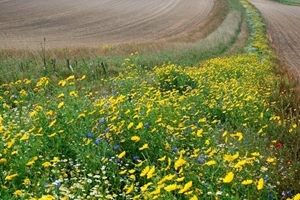 The current agri-environment schemes across the UK include options that can provide benefits for farmland wildlife yet declines continue in farmland birds and we suspect for other wildlife such as bees and butterflies. Uptake of some of the most valuable options, such as nectar-flower and wild bird seed mixtures is relatively low. To improve uptake making agri-environment scheme habitats multi-functional, easier to manage, cheaper with better and more consistent quality would make them more attractive to land managers.
The current agri-environment schemes across the UK include options that can provide benefits for farmland wildlife yet declines continue in farmland birds and we suspect for other wildlife such as bees and butterflies. Uptake of some of the most valuable options, such as nectar-flower and wild bird seed mixtures is relatively low. To improve uptake making agri-environment scheme habitats multi-functional, easier to manage, cheaper with better and more consistent quality would make them more attractive to land managers.
In 2009, in conjunction with Conservation Grade, we started a project to develop multi-purpose wildlife crops. This was comprised of two components. In the first, a trial was established to compare to compare a new seed mix for establishing along hedgerows. Many hedgerow bases have become floristically impoverished dominated by nettles and hogweed, whilst wildflowers have disappeared. A hedgerow seed mixes containing more typical hedgerow species than usually found in wildflower mixes was developed. This was sown in a replicated trial with and without grasses and at two seed rates. These mixes were also compared to a standard wildflower mixes that is widely used along field margins.
We found that establishment of perennial flowering plants along hedgerows was improved if grasses were not included in the original seed mix. A more diverse plant community was established using the hedgerow seed mix compared to the currently recommended wildflower mix, although few typical hedgerow species established. There were no differences in the invertebrate functional groups (chick-food for farmland birds or pest natural enemies) between the different mixes. However, bumblebee abundance and diversity was significantly lower in the hedgerow mix with grass and highest in that without grass at full seed rate. In contrast, butterfly abundance and species richness was higher when grass was included and highest in the wildflower mix, probably because this contained more host plant species.
In the second component of the project, we investigated whether a two-year legume/grass mix could build sufficient soil fertility to improve the growth of the following wild bird seed crop. The wider biodiversity value of these habitats was also measured. Over the course of the rotation, the habitats would be expected to provide a source of pollen and nectar for pollinating insects, seed food in winter and insect food in summer for farmland birds and build soil fertility so that crops are self-sustaining.
We found that the legume ley improved soil nutrients including nitrogen levels by an average of 28kg/ha and up to 188kg/ha in some plots. The weight of the wild bird seed plants was no different following the ley compared to controls that were cropped. The cover of broad-leaved weeds in the wild bird seed mix was lower in July following the legume ley; grass weeds were unaffected. The legume mix contained higher densities of chick-food insects including those important for grey partridge, pest natural enemies and pollinators than grass margins, wildflower strips and wild bird seed mixtures comprised of only cereal or mixed with some broad-leaf crops. However, a broad-leaf wild bird seed mix of brown mustard, fodder radish, oilseed rape and linseed was equally as good for chick-food insects.
In other trials comparing a legume mix to simple, average and complex wildflower mixes, the abundance of grey partridge chick-food was higher, but overall invertebrate diversity increased with floral complexity. Using human-imprinted grey partridge chicks revealed that their diet did not vary between the mixes but the legumes and more complex flower mixes inhibited movement.
Overall we recommended that legume-based flower mixes can provide a reliable source of flowers for pollinators and other insects, but wildflower mixes containing a wider range of flower types should also be established to extend the period when flowers are present and support a wider diversity of insects. Likewise, the value of wild bird seed mixes can also be improved by using broad-leaf plants alone and by including them in the mix.
Our thanks to Conservation Grade, Wixamtree Trust, John Oldacre Foundation and Kings Game Cover and Conservation Crops for their kind support of the multi-purpose wildlife crops project.